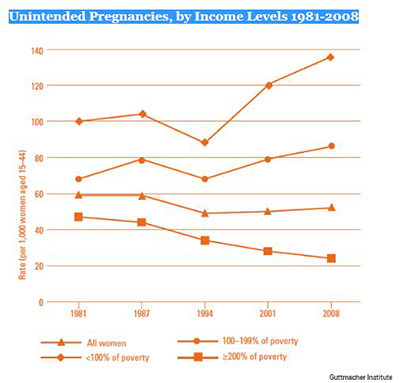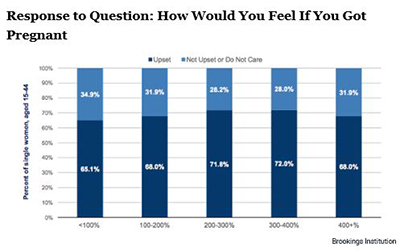
 “Modern long-acting contraceptives offer women impressive protection, literally toggling the fertility default setting to ‘off’ until a woman wants it on. But as with so many empowering tools, access is least available to those most vulnerable to having their family wellbeing, dreams and opportunities derailed.” (Photo: IUD via Shutterstock; Edited: LW / TO)
“Modern long-acting contraceptives offer women impressive protection, literally toggling the fertility default setting to ‘off’ until a woman wants it on. But as with so many empowering tools, access is least available to those most vulnerable to having their family wellbeing, dreams and opportunities derailed.” (Photo: IUD via Shutterstock; Edited: LW / TO)
Unwanted pregnancy is contributing to a new “caste system” in America according to a new Guttmacher report. Is that about to get worse?
When new and better technologies become available only to people who are already privileged, the rich get richer and opportunity gaps get wider. That’s exactly what’s happening with family planning—and unless trends change, a recent revolution in contraceptive technology may deepen America’s economic divide.
Many factors intersect to create poverty or keep people mired there: racism, sexism, untreated illness and mental illness, hopelessness created by lack of opportunity, structural barriers between social classes, and more. Disruptive, unsought pregnancy and childbearing is one of these factors, both a cause and consequence of poverty. Modern long- acting contraceptives offer women impressive protection, literally toggling the fertility default setting to “off” until a woman wants it on. But as with so many empowering tools, access is least available to those most vulnerable to having their family wellbeing, dreams and opportunities derailed.
The Lucky Ones
My daughters both headed to college in the last two years, along with a flock of friends who have been raiding our refrigerator since middle school. As the children of middle class and professional mothers, many of the girls left home with the best birth control that money can buy—state of the art IUD’s or implants that drop the rate of surprise pregnancy below 1 in 500 annually and last for years. We moms might not be able to prepare our girls for sexual pressures that didn’t exist back in the day, but we could virtually guarantee that a daughter we loved wasn’t going to have her education and dreams derailed by two pink lines on a pregnancy test.
For both males and females, but especially for young women, being able to reach educational goals and settle into a career before parenthood offers a huge boost to lifelong prosperity. It also stacks the odds in favor of a stable partnership and healthy children who then go on to have healthy, prosperous kids of their own. Strong girls with strong social support can sometimes carve out impressive paths for themselves despite early unexpected pregnancy. But stories of their achievements captivate us because they are heroic—and the exception to the rule.
The High Human Cost of Poor Contraception
Very few young single mothers get pregnant because they actually want to. Even fewer plan and prepare for pregnancy or obtain recommended preconception care. Today, 82 percent of teen pregnancies and 70 percent of pregnancies among single woman under the age of thirty are unintended, and most of those children are born into poverty. The consequences of those pregnancies are enormous: more abortions, less healthy moms and babies, more infant death, more high school drop-outs, college foregone, lost earning potential, domestic violence, repeated disruptions in family structure as young moms try to find reliable partnerships, more mental health problems and anti-social behavior in children, and public budgets stretched to the breaking point as states try to fill in resources and services once provided by stable families.
 The part that’s most cruel is the growing split in who does and doesn’t get hit by the tsunami of hardship linked to ill-timed or unwanted pregnancy–a divide so dramatic that some have called it an emerging “caste system.” In 2008 unplanned pregnancy was five times as common for women below the poverty level as those above.
The part that’s most cruel is the growing split in who does and doesn’t get hit by the tsunami of hardship linked to ill-timed or unwanted pregnancy–a divide so dramatic that some have called it an emerging “caste system.” In 2008 unplanned pregnancy was five times as common for women below the poverty level as those above.
Across race and class divides in the U.S., young women voice surprisingly similar aspirations regarding when they ideally would like to have kids—how many and under what circumstances. But there the similarity ends. Girls who have grown up with the benefits of financial security and higher education have more and better tools to manage their fertility—and they tend to bring children into the world when they feel ready.
 By contrast, girls raised in families that are up against the hard edges of life, those fighting to make ends meet on low wages in rough communities, depend on cheaper and less effective birth control—or crossed fingers—and they often end up with very different lives than the ones they dreamed of. Their desire to get ready before getting pregnant crumbles against a wall of disempowerment: low access to sexual health information, financial barriers to medical care, cultural disruption, racism and classism, a social fabric of low expectations, gender based violence, and more. Unintended pregnancy is the top reason teens drop out of high school, and less than 2 percent of these young mothers go on to complete college by age 30. It’s a formula for multi-generational poverty.
By contrast, girls raised in families that are up against the hard edges of life, those fighting to make ends meet on low wages in rough communities, depend on cheaper and less effective birth control—or crossed fingers—and they often end up with very different lives than the ones they dreamed of. Their desire to get ready before getting pregnant crumbles against a wall of disempowerment: low access to sexual health information, financial barriers to medical care, cultural disruption, racism and classism, a social fabric of low expectations, gender based violence, and more. Unintended pregnancy is the top reason teens drop out of high school, and less than 2 percent of these young mothers go on to complete college by age 30. It’s a formula for multi-generational poverty.
How Revolutionary Contraceptives Change the Equation
My daughters are beneficiaries of a technology revolution in contraception, the biggest leap forward since the Pill became available in the 1960’s. The current technology shift is a transition from every-day or every-time methods like the Pill and condom to long acting reversible contraceptives known for short as LARCs. LARCs include hormonal and non-hormonal IUD’s and contraceptive implants.
Pills and condoms work great in the lab, but in the real world where most of us live, they produce annual pregnancy rates of 1 in 11 and 1 in 6 respectively, mostly because it’s so hard to use them consistently and perfectly. Pills and condoms are way better than the desperate measures taken by our ancestors (Metal pessaries? Weasel testicles? Eew!), but the statistics are still painful. After 50 years of widely available pills and condoms, half of pregnancies in the U.S. are unplanned, and despite the shame and stigma, 1 in 3 women has an abortion at some point before hitting menopause.
With a LARC, surprise pregnancy becomes truly surprising. Annual failure rates range from 1 in 500 to 1 in 2000, depending on the method. The game-changer is that long acting contraceptives toggle the fertility default to off until a woman wants it on. No one method works for everyone. But once an IUD or implant is settled into place, ambivalence, intoxication, impulsivity, sexual coercion or general life chaos no longer puts a young woman on the path to premature parenthood. Pregnancy is opt-in rather than opt-out.
When she is ready, a woman who wants a baby simply has her LARC removed. (She can expect the same rate of fertility she would have had without it.) Then, immediately after giving birth, she can have a new one placed so that she is protected again until she wants another child. LARCs that are provided in the hospital at the time of labor and delivery are called “bedside LARCs.” They are safe for breastfeeding and help to prevent rapid repeat pregnancies, which tend to be higher in risk because a new mother’s physical reserves are low. Bedside LARC is the cutting edge of contraceptive care.
Fair Access Essential to Narrow Inequality
Middle and upper middle class teens and women are making the transition to top tier long acting contraceptives and reaping the benefits, but “the best birth control money can buy” has a high up front cost, as much as $1000. For many emerging adults, coming up with that kind of cash is unimaginable. The Obamacare contraceptive mandate may eventually make these life-changing technologies available to all with no surcharge. Large scale research suggests that when this happens a high percent of teens and women will choose LARCs for themselves and the rates of teen pregnancy and abortion will plummet. In the meantime, religious and political conflict, coupled with outdated medical practices and other bureaucratic challenges means that top tier methods are not consistently available to young and poor women—in other words, those who are the most vulnerable to ill-timed pregnancy and least able to take the hit.
The fortunate young women I have watched growing up can pursue their dreams with a high level of confidence that they won’t get derailed by a surprise pregnancy. For a young woman relying on pills or condoms or her boyfriend’s ability to pull out, that simply isn’t true. Unless we want to see America’s economic divide grow wider and deeper, we need to ensure that reliable, state-of-the-art family planning options are equally available to emerging adults from all stations in life.
Defying Trump’s right-wing agenda from Day One
Inauguration Day is coming up soon, and at Truthout, we plan to defy Trump’s right-wing agenda from Day One.
Looking to the first year of Trump’s presidency, we know that the most vulnerable among us will be harmed. Militarized policing in U.S. cities and at the borders will intensify. The climate crisis will deteriorate further. The erosion of free speech has already begun, and we anticipate more attacks on journalism.
It will be a terrifying four years to produce social justice-driven journalism. But we’re not falling to despair, because we know there are reasons to believe in our collective power.
The stories we publish at Truthout are part of the antidote to creeping authoritarianism. And this year, we promise we will kick into an even higher gear to give you truthful news that cuts against the disinformation, vitriol, hate and violence. We promise to publish analyses that will serve the needs of the movements we all rely on to survive the next four years, and even build for the future. We promise to be responsive, to recognize you as members of our community with a vital stake and voice in this work.
Please show your support for Truthout with a tax-deductible donation (either once today or on a monthly basis).